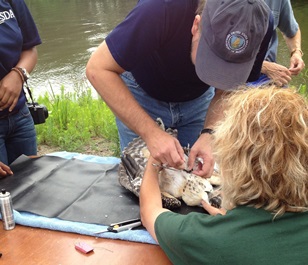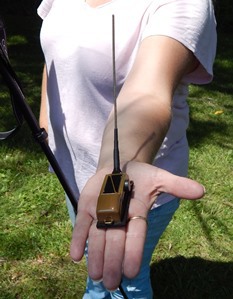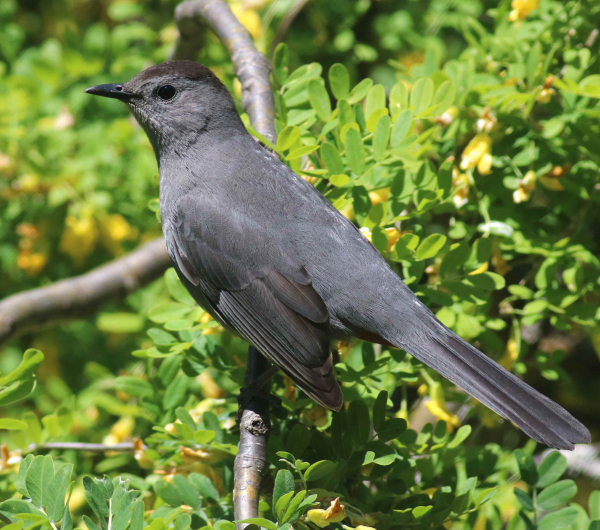Four osprey chicks sport GPS satellite backpacks
 As Michigan’s osprey population continues to rebound, the Department of Natural Resources is tracking the revitalization of this species in southern Michigan through monitoring efforts. This year, four osprey chicks from area nests were outfitted with “backpack” GPS/GSM telemetry units. Funded by donations from DTE Energy, Huron Valley Audubon and Michigan Osprey volunteers Martha Wolf and Barb Jensen, these units will help scientists track the young birds’ daily movements and seasonal migration patterns.
As Michigan’s osprey population continues to rebound, the Department of Natural Resources is tracking the revitalization of this species in southern Michigan through monitoring efforts. This year, four osprey chicks from area nests were outfitted with “backpack” GPS/GSM telemetry units. Funded by donations from DTE Energy, Huron Valley Audubon and Michigan Osprey volunteers Martha Wolf and Barb Jensen, these units will help scientists track the young birds’ daily movements and seasonal migration patterns.
The chicks were hatched in nests on platforms at Kensington Metropark in Milford and Sterling State Park in Monroe. Crews from Clearlink Wireless Solutions, Skyline Services LLC, Newkirk-Electric and Earthcom Inc. climbed the towers to access the chicks for banding and transmitter deployment.
“We are very excited to have this opportunity to place GPS units on several ospreys this year,” said Julie Oakes, DNR wildlife biologist. “This will provide us with information on what migration routes the birds take and will give us insight into what perils they must endure on their migration.”
 Anyone can follow the movement of the birds by visiting the Michigan osprey website at www.michiganosprey.org. Move the cursor along the route to see GPS coordinates and time and date information for each leg of an osprey’s journey. The youngsters will begin their migration in early to mid-September. It likely will be a couple of years before they return, since ospreys generally spend their first two years or so in Central America and South America before returning northward to nest.
Anyone can follow the movement of the birds by visiting the Michigan osprey website at www.michiganosprey.org. Move the cursor along the route to see GPS coordinates and time and date information for each leg of an osprey’s journey. The youngsters will begin their migration in early to mid-September. It likely will be a couple of years before they return, since ospreys generally spend their first two years or so in Central America and South America before returning northward to nest.
In 1998, the DNR began to relocate ospreys to southern Michigan. The program, supported by donations to Michigan’s Nongame Wildlife Fund, involved relocating chicks from nests in northern Michigan and rearing them in man-made towers in southern Michigan, through a process called “hacking.” Relocation efforts occurred over a span of 10 years. In 2013, the DNR, along with volunteers from Michigan Osprey, identified at least 56 active nests in southern Michigan – an amazing increase from the single active nest reported in 2002.
“This is a true wildlife success story,” said Oakes. “Each year we have new nests. We have already exceeded our original goal of 30 active nests by 2020. We have been able to remove ospreys from the threatened species list and restore their numbers in Michigan.”
Historically, osprey chicks have been banded each year as part of a national effort to monitor the species. Banding continues this year as a cooperative venture of the Michigan DNR, Huron-Clinton Metroparks, the Detroit Zoological Society and Michigan Osprey.
Because ospreys often nest on cell-phone towers, staff from cell-phone tower companies – including American Tower Corporation, Verizon Wireless, McFarlin Tower, Skyline Services LLC, Earthcom, Hydaker-Wheatlake Inc., Newkirk Electric, Clearlink Wireless Solutions and Crown Castle International – are invaluable partners in osprey monitoring. Their staff members alert the DNR and Michigan Osprey to osprey nests, assist with the retrieval of chicks during the banding process and delay tower repair projects until after the nesting season.
Other partners in this monitoring effort include the Huron Valley Audubon Society, Michigan Audubon, volunteers from Michigan Osprey and the U.S. Department of Agriculture Wildlife Services.
Anyone who observes a nesting pair of ospreys in southeast Michigan is asked to report the sighting via the Michigan Osprey website at www.michiganosprey.org.





